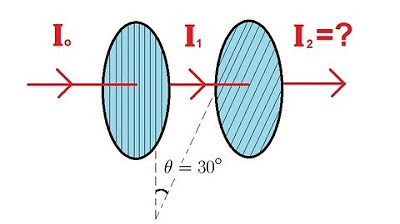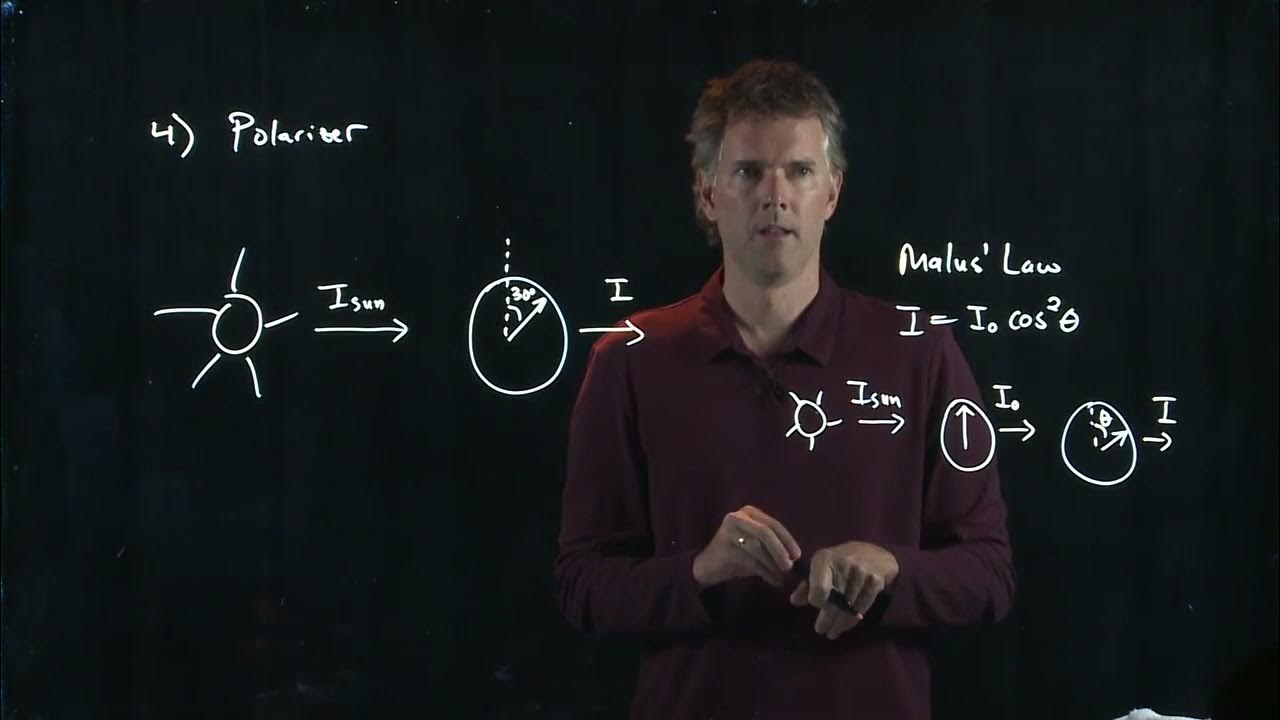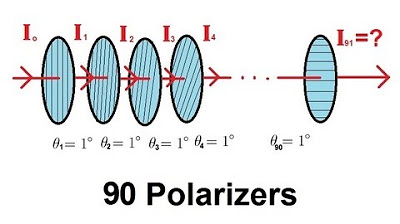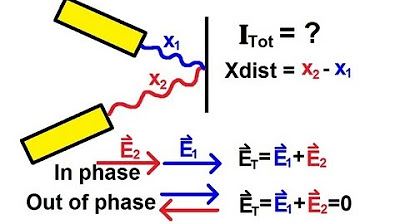Physics 53 Polarization (3 of 5) Three Polarizers
TLDRThis educational script explores the intriguing behavior of light passing through multiple polarizers. It begins with a setup of three polarizers, oriented at 90°, 45°, and another 45° relative to the first, contrary to the expectation of no light transmission with two perpendicular polarizers. The script delves into the mathematical calculation of light intensity after passing each polarizer, revealing a surprising result of 12.5% of the original intensity reaching the final polarizer. This phenomenon challenges common assumptions and offers a deeper understanding of polarized light.
Takeaways
- 🔍 The example involves using three polarizers.
- 🔀 The first polarizer is perpendicular to the second, which is at a 45° angle to the first.
- 📏 The third polarizer is at a 45° angle to the second, making it perpendicular to the first.
- 🔎 Initially, with only two perpendicular polarizers, no light intensity would pass through.
- 💡 Adding a third polarizer changes the result, allowing some light to pass through.
- 📉 After light passes through the first polarizer, its intensity is reduced to half.
- 📐 The intensity after the second polarizer is calculated using the cosine squared of the angle (45°), resulting in a quarter of the initial intensity.
- 🔬 The final intensity after the third polarizer is also calculated using the cosine squared of the angle (45°).
- 📊 The light intensity after passing through all three polarizers is 12.5% of the original intensity.
- 🔄 The process demonstrates that more than two polarizers can allow some light to pass through, contrary to the expectation with just two perpendicular polarizers.
Q & A
What is the initial light intensity after passing through the first polarizer?
-After passing through the first polarizer, the light intensity is reduced to half of its initial intensity, represented as \( I_1 = \frac{1}{2} I_0 \).
Why does the light intensity decrease when it passes through the second polarizer?
-The light intensity decreases because the second polarizer is oriented at a 45° angle relative to the first one, which means only the component of the light's intensity that is aligned with the second polarizer's axis will pass through.
What mathematical operation is used to calculate the light intensity after the second polarizer?
-The light intensity after the second polarizer is calculated by multiplying the intensity after the first polarizer, \( I_1 \), with the square of the cosine of the angle between the polarizers, which is \( I_2 = I_1 \times \cos^2(45°) \).
What is the numerical value of the cosine of 45 degrees and how is it used in the calculation?
-The cosine of 45 degrees is approximately 0.707 (or 7/10 when expressed as a fraction). It is used in the calculation to determine the intensity of light that passes through the second polarizer, which is then squared to get 0.5.
How much of the original light intensity remains after passing through the second polarizer?
-After passing through the second polarizer, the light intensity is reduced to a quarter of the original intensity, represented as \( I_2 = 0.25 I_0 \).
What is the relationship between the orientation of the third polarizer and the first one?
-The third polarizer is oriented at a 45° angle relative to the second one, which means it is perpendicular to the first polarizer.
How is the light intensity calculated after passing through the third polarizer?
-The light intensity after the third polarizer is calculated by multiplying the intensity after the second polarizer, \( I_2 \), with the square of the cosine of the 45° angle again, which is \( I_3 = I_2 \times \cos^2(45°) \).
What is the final light intensity after all three polarizers, and how does it compare to the initial intensity?
-The final light intensity after all three polarizers is 12.5% of the initial intensity, represented as \( I_3 = 0.125 I_0 \), which is not zero as one might expect with just two perpendicular polarizers.
Why is there still some light intensity after passing through three polarizers set in this specific configuration?
-There is still some light intensity because the specific angles and the number of polarizers create a situation where the light's orientation is partially aligned with the third polarizer, allowing some light to pass through.
What does this example demonstrate about the behavior of polarized light?
-This example demonstrates that the intensity of polarized light can be non-zero even after passing through multiple polarizers set at specific angles, challenging the expectation that light would be blocked by a perpendicular polarizer.
What is the significance of the cosine squared term in the calculations for each polarizer?
-The cosine squared term represents the fraction of light intensity that is aligned with the transmission axis of the polarizer. It is used to calculate the intensity of light that passes through each subsequent polarizer.
Outlines
🔬 Light Intensity Through Multiple Polarizers
This paragraph discusses an experiment involving three polarizers arranged at specific angles to each other. The first polarizer is perpendicular to the light source, the second is at a 45° angle to the first, and the third is also at a 45° angle to the second, effectively being perpendicular to the first. The script explains the surprising result that light intensity is not completely blocked even with three polarizers, contrary to what would be expected with just two. The explanation involves calculating the light intensity after passing through each polarizer, using the cosine of the angles involved. The initial intensity is halved after the first polarizer, then further reduced to a quarter after the second, and finally, it is calculated that 12.5% of the original intensity makes it through the third polarizer, demonstrating a fascinating property of polarized light.
Mindmap
Keywords
💡Polarizers
💡Light Intensity
💡Perpendicular
💡45° Angle
💡Cosine
💡Intensity Calculation
💡Initial Intensity
💡Transmitted Light
💡Polarization
💡Experiment
💡Non-Zero Transmission
Highlights
Introduction of an example involving the use of three polarizers.
First polarizer is set perpendicular to the light source.
Second polarizer is positioned at a 45° angle relative to the first.
Third polarizer is also at a 45° angle, but relative to the second one, making it perpendicular to the first.
Expected no light intensity to pass through two perpendicular polarizers.
Demonstration of a surprising result when using three polarizers.
Initial light intensity (I sub 0) is considered as 1.
After the first polarizer, light intensity is halved (I sub 1 = 0.5 * I sub 0).
Intensity through the second polarizer is calculated using the cosine squared of the angle (I sub 2 = I sub 1 * cos^2(45°)).
Light intensity after the second polarizer is 1/4 of the original (I sub 2 = 0.25 * I sub 0).
Intensity through the third polarizer is also calculated using the cosine squared of the angle.
Final light intensity after all three polarizers is not zero but 12.5% of the original (I sub 3 = 0.125 * I sub 0).
The phenomenon where light intensity is not completely blocked by multiple polarizers is highlighted.
Explanation of the mathematical process involved in calculating light intensity through polarizers.
The importance of angle and its cosine in determining light intensity after passing through polarizers.
The surprising outcome that more than two polarizers can allow some light to pass through.
Invitation to stay tuned for another example, indicating a series of educational content.
Transcripts
Browse More Related Video

Physics 53 Polarization (2 of 5) Two Polarizers

The Polarizer | Physics with Professor Matt Anderson | M28-17

Physics 53 Polarization (4 of 5) Ninety Polarizers

Polarization of light, linear and circular | Light waves | Physics | Khan Academy

Physics 60 Interference of Light (1 of 8) Path and Phase Difference: Introduction

I didn't believe that light slows down in water (part 1)
5.0 / 5 (0 votes)
Thanks for rating: